Characteristics of Soil Heavy Metal Pollution and Health Risk Assessment in Urban Parks at a Megacity of Central China
Abstract
1. Introduction
2. Materials and Methods
2.1. Study Area and Soil Sampling
2.2. Sample Analysis
2.3. Data Analysis
2.3.1. Enrichment Factors
2.3.2. Source Apportionment Model
2.3.3. Human Health Risk Assessment
2.3.4. Probabilistic Health Risk Assessment
3. Results and Discussion
3.1. Characteristics of Heavy Metal Concentrations
3.2. Heavy Metal Enrichment Factors
3.3. Spatial Distributions of Heavy Metals
3.4. Source Apportionment of the Heavy Metals
3.4.1. Correlation Analysis
3.4.2. Analysis of PMF Model Sources
3.5. Probabilistic Health Risks Assessment
3.5.1. Noncancer Risk Assessment
3.5.2. Cancer Risk
3.5.3. Impacts and Recommendations
4. Conclusions
Supplementary Materials
Author Contributions
Funding
Institutional Review Board Statement
Informed Consent Statement
Data Availability Statement
Conflicts of Interest
References
- Gu, J.; Qin, C.; Wu, Z. Quadricuspid aortic valve with D (Rho) antigen negativity: A novel case report. Anatol. J. Cardiol. 2017, 17, 164. [Google Scholar] [CrossRef] [PubMed]
- Wang, M.; Han, Q.; Gui, C.; Cao, J.; Liu, Y.; He, X.; He, Y. Differences in the risk assessment of soil heavy metals between newly built and original parks in Jiaozuo, Henan Province, China. Sci. Total Environ. 2019, 676, 1–10. [Google Scholar] [CrossRef] [PubMed]
- Kuzmanoski, M.; Todorovic, M.; Anicic-Urosevic, M.; Rajsic, S. Heavy metal content of soil in urban parks of Belgrade. Hem. Ind. 2014, 68, 643–651. [Google Scholar] [CrossRef]
- Wei, B.; Yang, L. A review of heavy metal contaminations in urban soils, urban road dusts and agricultural soils from China. Microchem. J. 2010, 94, 99–107. [Google Scholar] [CrossRef]
- Jiao, W.; Ouyang, W.; Hao, F.; Huang, H.; Shan, Y.; Geng, X. Combine the soil water assessment tool (SWAT) with sediment geochemistry to evaluate diffuse heavy metal loadings at watershed scale. J. Hazard Mater. 2014, 280, 252–259. [Google Scholar] [CrossRef]
- Mishra, S.; Bharagava, R.N.; More, N.; Yadav, A.; Zainith, S.; Mani, S.; Chowdhary, P. Heavy Metal Contamination: An Alarming Threat to Environment and Human Health. In Environmental Biotechnology: For Sustainable Future; Springer: Berlin/Heidelberg, Germany, 2019; pp. 103–125. [Google Scholar]
- Chen, Y. Review on Heavy Metal Pollution of Urban Soil and Its Control in China. China Popul. Resour. Environ. 2011, 21, 536–539. [Google Scholar]
- Su, C.; Jiang, L.; Zhang, W. A review on heavy metal contamination in the soil worldwide:Situation, impact and remediation techniques. Environ. Skept. Crit. 2014, 3, 24–38. [Google Scholar]
- Mani, S.; Bharagava, R.N. Exposure to Crystal Violet, Its Toxic, Genotoxic and Carcinogenic Effects on Environment and Its Degradation and Detoxification for Environmental Safety. Rev. Environ. Contam. Toxicol. 2016, 237, 71–104. [Google Scholar] [CrossRef]
- Martin, S.; Griswold, W. Human Health Effects of Heavy Metals. Environ. Sci. Technol. Briefs Citiz. 2009, 15, 1–6. [Google Scholar]
- Han, Q.; Wang, M.; Cao, J.; Gui, C.; Liu, Y.; He, X.; He, Y.; Liu, Y. Health risk assessment and bioaccessibilities of heavy metals for children in soil and dust from urban parks and schools of Jiaozuo, China. Ecotoxicol. Environ. Saf. 2020, 191, 110157. [Google Scholar] [CrossRef]
- Huang, J.; Wu, Y.; Sun, J.; Li, X.; Geng, X.; Zhao, M.; Sun, T.; Fan, Z. Health risk assessment of heavy metal(loid)s in park soils of the largest megacity in China by using Monte Carlo simulation coupled with Positive matrix factorization model. J. Hazard Mater. 2021, 415, 125629. [Google Scholar] [CrossRef] [PubMed]
- Cai, L.M.; Wang, Q.S.; Wen, H.H.; Luo, J.; Wang, S. Heavy metals in agricultural soils from a typical township in Guangdong Province, China: Occurrences and spatial distribution. Ecotoxicol. Environ. Saf. 2019, 168, 184–191. [Google Scholar] [CrossRef]
- Sutherland, R.A. Bed sediment-associated trace metals in an urban stream, Oahu, Hawaii. Environ. Geol. 2000, 39, 611–627. [Google Scholar] [CrossRef]
- Callen, M.S.; Iturmendi, A.; Lopez, J.M. Source apportionment of atmospheric PM2.5-bound polycyclic aromatic hydrocarbons by a PMF receptor model. Assessment of potential risk for human health. Environ. Pollut. 2014, 195, 167–177. [Google Scholar] [CrossRef]
- Haji Gholizadeh, M.; Melesse, A.M.; Reddi, L. Water quality assessment and apportionment of pollution sources using APCS-MLR and PMF receptor modeling techniques in three major rivers of South Florida. Sci. Total Environ. 2016, 566, 1552–1567. [Google Scholar] [CrossRef] [PubMed]
- Liang, J.; Feng, C.; Zeng, G.; Gao, X.; Zhong, M.; Li, X.; Li, X.; He, X.; Fang, Y. Spatial distribution and source identification of heavy metals in surface soils in a typical coal mine city, Lianyuan, China. Environ. Pollut. 2017, 225, 681–690. [Google Scholar] [CrossRef]
- Jiang, H.H.; Cai, L.M.; Hu, G.C.; Wen, H.H.; Luo, J.; Xu, H.Q.; Chen, L.G. An integrated exploration on health risk assessment quantification of potentially hazardous elements in soils from the perspective of sources. Ecotoxicol. Environ. Saf. 2021, 208, 111489. [Google Scholar] [CrossRef]
- Jiang, H.H.; Cai, L.M.; Wen, H.H.; Hu, G.C.; Chen, L.G.; Luo, J. An integrated approach to quantifying ecological and human health risks from different sources of soil heavy metals. Sci. Total Environ. 2020, 701, 134466. [Google Scholar] [CrossRef]
- Rinklebe, J.; Antoniadis, V.; Shaheen, S.M.; Rosche, O.; Altermann, M. Health risk assessment of potentially toxic elements in soils along the Central Elbe River, Germany. Environ. Int. 2019, 126, 76–88. [Google Scholar] [CrossRef]
- Chen, H.; Wang, L.; Hu, B.; Xu, J.; Liu, X. Potential driving forces and probabilistic health risks of heavy metal accumulation in the soils from an e-waste area, southeast China. Chemosphere 2022, 289, 133182. [Google Scholar] [CrossRef]
- USEPA. Exposure Factors Handbook, Final ed.; U.S. Environment Protection Agency: Washington, DC, USA, 2011.
- Chai, L.; Wang, Y.; Wang, X.; Ma, L.; Cheng, Z.; Su, L. Pollution characteristics, spatial distributions, and source apportionment of heavy metals in cultivated soil in Lanzhou, China. Ecol. Indic. 2021, 125, 107507. [Google Scholar] [CrossRef]
- China National Environmental Monitoring Station. Background Values of Soil Elements in China; China Environmental Science Press: Beijing, China, 1990. [Google Scholar]
- GB 15618-2018 [S]; Soil Environmental Quality Standard for Risk Management and Control of Agricultural Land Soil Pollution (Trial). The Standardization Administration of the People’s Republic of China: Beijing, China, 2018.
- Gredilla, A.; Fdez-Ortiz de Vallejuelo, S.; Gomez-Nubla, L.; Carrero, J.A.; de Leao, F.B.; Madariaga, J.M.; Silva, L.F.O. Are children playgrounds safe play areas? Inorganic analysis and lead isotope ratios for contamination assessment in recreational (Brazilian) parks. Environ. Sci. Pollut. Res. Int. 2017, 24, 24333–24345. [Google Scholar] [CrossRef] [PubMed]
- Brtnicky, M.; Pecina, V.; Hladky, J.; Radziemska, M.; Koudelkova, Z.; Klimanek, M.; Richtera, L.; Adamcova, D.; Elbl, J.; Galiova, M.V.; et al. Assessment of phytotoxicity, environmental and health risks of historical urban park soils. Chemosphere 2019, 220, 678–686. [Google Scholar] [CrossRef] [PubMed]
- Nezat, C.A.; Hatch, S.A.; Uecker, T. Heavy metal content in urban residential and park soils: A case study in Spokane, Washington, USA. Appl. Geochem. 2017, 78, 186–193. [Google Scholar] [CrossRef]
- Rate, A.W. Multielement geochemistry identifies the spatial pattern of soil and sediment contamination in an urban parkland, Western Australia. Sci. Total Environ. 2018, 627, 1106–1120. [Google Scholar] [CrossRef]
- Khan, S.; Munir, S.; Sajjad, M.; Li, G. Urban park soil contamination by potentially harmful elements and human health risk in Peshawar City, Khyber Pakhtunkhwa, Pakistan. J. Geochem. Explor. 2016, 165, 102–110. [Google Scholar] [CrossRef]
- Liu, L.; Liu, Q.; Ma, J.; Wu, H.; Qu, Y.; Gong, Y.; Yang, S.; An, Y.; Zhou, Y. Heavy metal(loid)s in the topsoil of urban parks in Beijing, China: Concentrations, potential sources, and risk assessment. Environ. Pollut. 2020, 260, 114083. [Google Scholar] [CrossRef]
- Qiang, L.; Yang, W.; Jingshuang, L.; Quanying, W.; Mingying, Z. Grain-size distribution and heavy metal contamination of road dusts in urban parks and squares in Changchun, China. Environ. Geochem. Health 2015, 37, 71–82. [Google Scholar] [CrossRef]
- Pekey, H.; Doğan, G. Application of positive matrix factorisation for the source apportionment of heavy metals in sediments: A comparison with a previous factor analysis study. Microchem. J. 2013, 106, 233–237. [Google Scholar] [CrossRef]
- Chen, H.; Teng, Y.; Li, J.; Wu, J.; Wang, J. Source apportionment of trace metals in river sediments: A comparison of three methods. Environ. Pollut. 2016, 211, 28–37. [Google Scholar] [CrossRef]
- Ahmed, F.; Ishiga, H. Trace metal concentrations in street dusts of Dhaka city, Bangladesh. Atmos. Environ. 2006, 40, 3835–3844. [Google Scholar] [CrossRef]
- Amato, F.; Pandolfi, M.; Viana, M.; Querol, X.; Alastuey, A.; Moreno, T. Spatial and chemical patterns of PM10 in road dust deposited in urban environment. Atmos. Environ. 2009, 43, 1650–1659. [Google Scholar] [CrossRef]
- Miguel, E.D.; Llamas, J.F.; Chacon, E.; Berg, T.; Larssen, S.; Royset, O.; Vadset, M. Origin and patterns of distribution of trace elements in street dust: Unleaded petrol and urban lead. Atmos. Environ. 1997, 31, 2733–2740. [Google Scholar] [CrossRef]
- Wenqing, L.; Ruifang, Y.; Li, F.; Deshuo, M.; Mingjun, M.; Gaofang, Y.; Nanjing, Z.; Tingting, G. A Review on Heavy Metal Pollution of Agricultural Land Soil in the Yangtze River Delta and Relevant Pollution Control Strategy. Chin. J. Eng. Sci. 2021, 23, 174–184. [Google Scholar] [CrossRef]
- Guan, Q.; Zhao, R.; Pan, N.; Wang, F.; Yang, Y.; Luo, H. Source apportionment of heavy metals in farmland soil of Wuwei, China: Comparison of three receptor models. J. Clean. Prod. 2019, 237, 117792. [Google Scholar] [CrossRef]
- Huang, C.C.; Cai, L.M.; Xu, Y.H.; Jie, L.; Chen, L.G.; Hu, G.C.; Jiang, H.H.; Xu, X.B.; Mei, J.X. A comprehensive exploration on the health risk quantification assessment of soil potentially toxic elements from different sources around large-scale smelting area. Environ. Monit. Assess. 2022, 194, 206. [Google Scholar] [CrossRef]
- Huang, C.C.; Cai, L.M.; Xu, Y.H.; Wen, H.H.; Jie, L.; Hu, G.C.; Chen, L.G.; Wang, H.Z.; Xu, X.B.; Mei, J.X. Quantitative analysis of ecological risk and human health risk of potentially toxic elements in farmland soil using the PMF model. Land Degrad. Dev. 2022, 33, 1954–1967. [Google Scholar] [CrossRef]
- Chen, X.; Xia, X.; Zhao, Y.; Zhang, P. Heavy metal concentrations in roadside soils and correlation with urban traffic in Beijing, China. J. Hazard Mater. 2010, 181, 640–646. [Google Scholar] [CrossRef] [PubMed]
- Garcia, R.; Millan, E. Assessment of Cd, Pb and Zn contamination in roadside soils and grasses from Gipuzkoa (Spain). Chemosphere 1998, 37, 1615–1625. [Google Scholar] [CrossRef]
- Councell, T.B.; Duckenfield, K.U.; Landa, E.R.; Callender, E. Tire-Wear Particles as a Source of Zinc to the Environment. Environ. Sci. Technol. 2004, 38, 4206–4214. [Google Scholar] [CrossRef]
- Zhang, H.; Huang, B.; Dong, L.; Hu, W.; Akhtar, M.S.; Qu, M. Accumulation, sources and health risks of trace metals in elevated geochemical background soils used for greenhouse vegetable production in southwestern China. Ecotoxicol. Environ. Saf. 2017, 137, 233–239. [Google Scholar] [CrossRef]
- Liu, H.; Anwar, S.; Fang, L.; Chen, L.; Xu, W.; Xiao, L.; Zhong, B.; Liu, D. Source Apportionment of Agricultural Soil Heavy Metals Based on PMF Model and Multivariate Statistical Analysis. Environ. Forensics 2022, 23, 1–9. [Google Scholar] [CrossRef]
- Lv, J.; Liu, Y.; Zhang, Z.; Dai, J.; Dai, B.; Zhu, Y. Identifying the origins and spatial distributions of heavy metals in soils of Ju country (Eastern China) using multivariate and geostatistical approach. J. Soils Sediments 2014, 15, 163–178. [Google Scholar] [CrossRef]
- Huang, S.W.; Jin, J.Y. Status of heavy metals in agricultural soils as affected by different patterns of land use. Environ. Monit. Assess. 2008, 139, 317–327. [Google Scholar] [CrossRef] [PubMed]
- Gimeno-Garcia, E.; Andreu, V.; Boluda, R. Heavy metals incidence in the application of inorganic fertilizers and pesticides to rice farming soils. Environ. Pollut. 1996, 92, 19–25. [Google Scholar] [CrossRef] [PubMed]
- Duzgoren-Aydin, N.S.; Li, X.D.; Wong, S.C. Lead contamination and isotope signatures in the urban environment of Hong Kong. Environ. Int. 2004, 30, 209–217. [Google Scholar] [CrossRef]
- Fong, F.T.; Chee, P.S.; Mahmood, A.A.; Tahir, N.M. Possible source and pattern distribution of heavy metals content in urban soil at Kuala Terengganu town center. Malays. J. Anal. Sci. 2008, 12, 458–467. [Google Scholar]
- Lee, C.S.; Li, X.; Shi, W.; Cheung, S.C.; Thornton, I. Metal contamination in urban, suburban, and country park soils of Hong Kong: A study based on GIS and multivariate statistics. Sci. Total Environ. 2006, 356, 45–61. [Google Scholar] [CrossRef]
- Yang, Z.; Lu, W.; Long, Y.; Bao, X.; Yang, Q. Assessment of heavy metals contamination in urban topsoil from Changchun City, China. J. Geochem. Explor. 2011, 108, 27–38. [Google Scholar] [CrossRef]
- Miner, D.K. Automotive Hydraulic Brake Tube: The Case for 90-10 Copper-Nickel Tubing. Sae Tech. Pap. Ser. 1993, 110, 931028. [Google Scholar]
- Ndiokwere, C.L. A Study of Heavy Metal Pollution from Motor Vehicle Emissions and Its Effect on Roadside Soil, Vegetation and Crops in Nigeria. Environ. Pollut. 1984, 7, 35–42. [Google Scholar] [CrossRef]
- Akhter, M.S.; Madany, I.M. Eavy metals in street and house dust in bahrain. Water Air Soil Pollut. 1993, 66, 111–119. [Google Scholar] [CrossRef]
- Xiang, M.; Li, Y.; Yang, J.; Lei, K.; Li, Y.; Li, F.; Zheng, D.; Fang, X.; Cao, Y. Heavy metal contamination risk assessment and correlation analysis of heavy metal contents in soil and crops. Environ. Pollut. 2021, 278, 116911. [Google Scholar] [CrossRef] [PubMed]
- Shen, W.; Hu, Y.; Zhang, J.; Zhao, F.; Bian, P.; Liu, Y. Spatial distribution and human health risk assessment of soil heavy metals based on sequential Gaussian simulation and positive matrix factorization model: A case study in irrigation area of the Yellow River. Ecotoxicol. Environ. Saf. 2021, 225, 112752. [Google Scholar] [CrossRef] [PubMed]
- Yu, S.; Chen, Z.; Zhao, K.; Ye, Z.; Zhang, L.; Dong, J.; Shao, Y.; Zhang, C.; Fu, W. Spatial Patterns of Potentially Hazardous Metals in Soils of Lin’an City, Southeastern China. Int. J. Environ. Res. Public Health 2019, 16, 246. [Google Scholar] [CrossRef]
- Shi, A.; Shao, Y.; Zhao, K.; Fu, W. Long-term effect of E-waste dismantling activities on the heavy metals pollution in paddy soils of southeastern China. Sci. Total Environ. 2020, 705, 135971. [Google Scholar] [CrossRef]
- Qin, G.; Niu, Z.; Yu, J.; Li, Z.; Ma, J.; Xiang, P. Soil heavy metal pollution and food safety in China: Effects, sources and removing technology. Chemosphere 2021, 267, 129205. [Google Scholar] [CrossRef]
- Wu, Q.; Hu, W.; Wang, H.; Liu, P.; Wang, X.; Huang, B. Spatial distribution, ecological risk and sources of heavy metals in soils from a typical economic development area, Southeastern China. Sci. Total Environ. 2021, 780, 146557. [Google Scholar] [CrossRef]
- Kim, W.; Song, I.; Shin, J.; Oh, C.; Kim, E.; Kim, K.; Kim, H.; Kim, J.; Choi, Y. A Study on Soil Contamination of Children’s Parks within the Gyeonggi-do Province Area. Korean J. Environ. Health Sci. 2017, 43, 233–239. [Google Scholar] [CrossRef]
- Dietrich, M.; Huling, J.; Krekeler, M.P.S. Metal pollution investigation of Goldman Park, Middletown Ohio: Evidence for steel and coal pollution in a high child use setting. Sci. Total Environ. 2018, 618, 1350–1362. [Google Scholar] [CrossRef]
- Dao, L.; Morrison, L.; Zhang, H.; Zhang, C. Influences of traffic on Pb, Cu and Zn concentrations in roadside soils of an urban park in Dublin, Ireland. Environ. Geochem. Health 2014, 36, 333–343. [Google Scholar] [CrossRef]
- Gąsiorek, M.; Kowalska, J.; Mazurek, R.; Pająk, M. Comprehensive assessment of heavy metal pollution in topsoil of historical urban park on an example of the Planty Park in Krakow (Poland). Chemosphere 2017, 179, 148–158. [Google Scholar] [CrossRef] [PubMed]
- Goksel, D.; Kurtulus, O.H.; Huseyin, O.; Osman, P.A.; Ilker, O.; Muhammet, B. Heavy metal concentrations of selected public parks of Istanbul City. MATEC Web Conf. 2016, 64, 2001. [Google Scholar]
- Zhang, Z.Y.; Yang, X.D.; Simay, Z.; Mohammed, A. Health risk evaluation of heavy metals in green land soils from urban parks in Urumqi, northwest China. Environ. Sci. Pollut. Res. 2018, 25, 4459–4473. [Google Scholar] [CrossRef] [PubMed]
- Gu, Y.-G.; Lin, Q.; Gao, Y.-P. Reprint of: Metals in exposed-lawn soils from 18 urban parks and its human health implications in southern China’s largest city, Guangzhou. J. Clean. Prod. 2017, 163, S164–S171. [Google Scholar] [CrossRef]
- Wang, L.; Chang, J.; Zheng, X.; Liu, J.; Yu, M.; Liu, L.; Yang, Y.; Zhang, H. Survey of ecological environmental conditions and influential factors for public parks in Shanghai. Chemosphere 2018, 190, 9–16. [Google Scholar] [CrossRef]
- Ferreira-Baptista, L.; De Miguel, E. Geochemistry and risk assessment of street dust in Luanda, Angola: A tropical urban environment. Atmos. Environ. 2005, 39, 4501–4512. [Google Scholar] [CrossRef]
- USDoE. The Risk Assessment Information System (RAIS); U.S. Department of Energy’s Oak Ridge: Oak Ridge, TN, USA, 2011. [Google Scholar]
- Zhang, Y.; Wang, S.; Gao, Z.; Zhang, H.; Zhu, Z.; Jiang, B.; Liu, J.; Dong, H. Contamination characteristics, source analysis and health risk assessment of heavy metals in the soil in Shi River Basin in China based on high density sampling. Ecotoxicol. Environ. Saf. 2021, 227, 112926. [Google Scholar] [CrossRef]
- USEPA. Environmental Protection Agency, Region 3, Risk Based Screening Tables (RSLs); Unites States Environmental Protection Agency: Washington, DC, USA, 2019. [Google Scholar]
- Yang, S.; Zhao, J.; Chang, S.X.; Collins, C.; Xu, J.; Liu, X. Status assessment and probabilistic health risk modeling of metals accumulation in agriculture soils across China: A synthesis. Environ. Int. 2019, 128, 165–174. [Google Scholar] [CrossRef]
- MEP. Ministry of environmental protection of the People's republic of China (MEP). In Exposure Factors Handbook of Chinese Population; China Environmental Science Press: Beijing, China, 2013. [Google Scholar]
- Liu, J.; Wang, Y.; Liu, X.; Xu, J. Occurrence and health risks of heavy metals in plastic-shed soils and vegetables across China. Agric. Ecosyst. Environ. 2021, 321, 107632. [Google Scholar] [CrossRef]
- Chen, H.; Teng, Y.; Lu, S.; Wang, Y.; Wu, J.; Wang, J. Source apportionment and health risk assessment of trace metals in surface soils of Beijing metropolitan, China. Chemosphere 2016, 144, 1002–1011. [Google Scholar] [CrossRef] [PubMed]
- Yang, Q.; Zhang, L.; Wang, H.; Martín, J.D. Bioavailability and health risk of toxic heavy metals (As, Hg, Pb and Cd) in urban soils: A Monte Carlo simulation approach. Environ. Res. 2022, 214, 113772. [Google Scholar] [CrossRef] [PubMed]
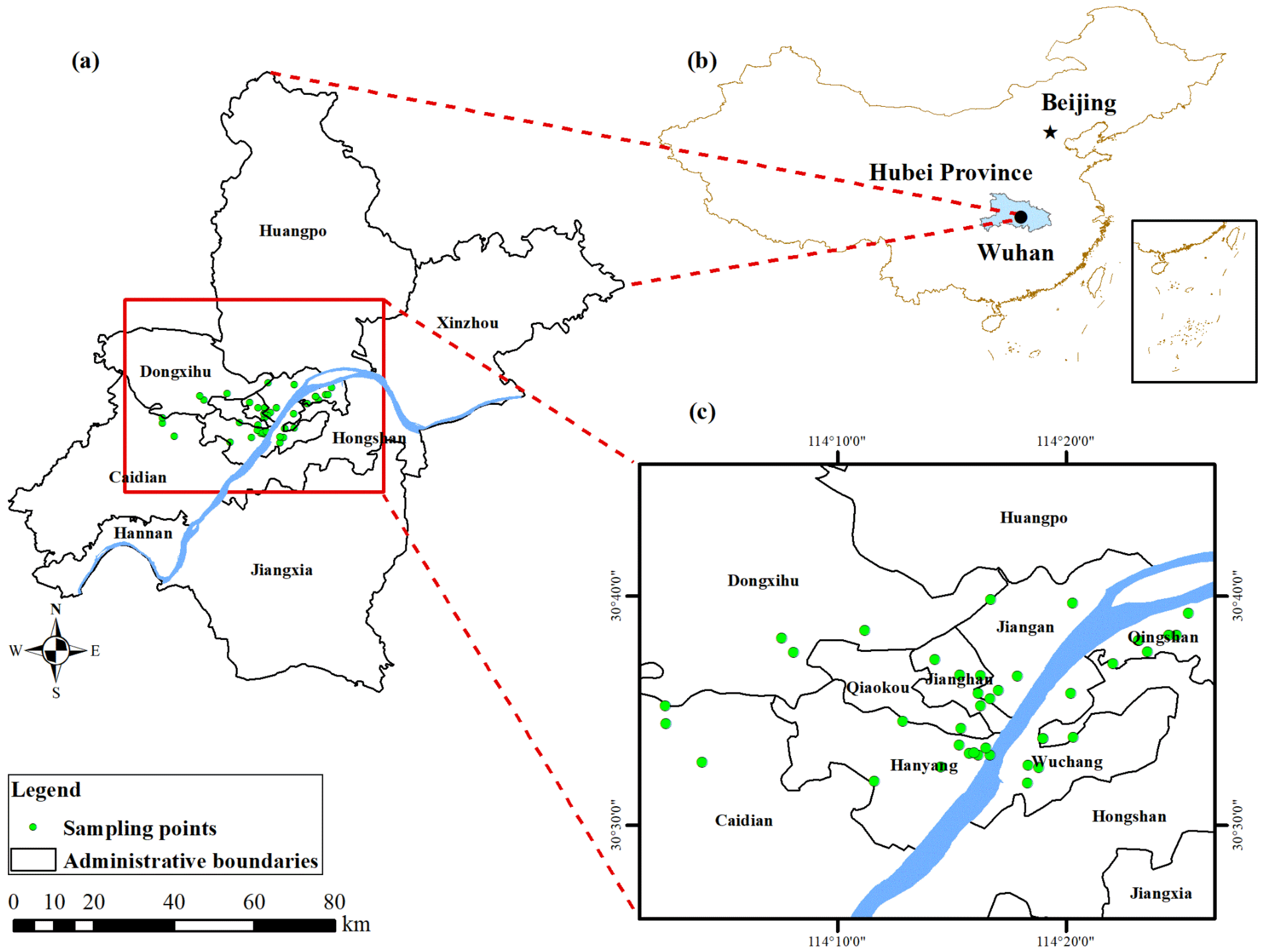
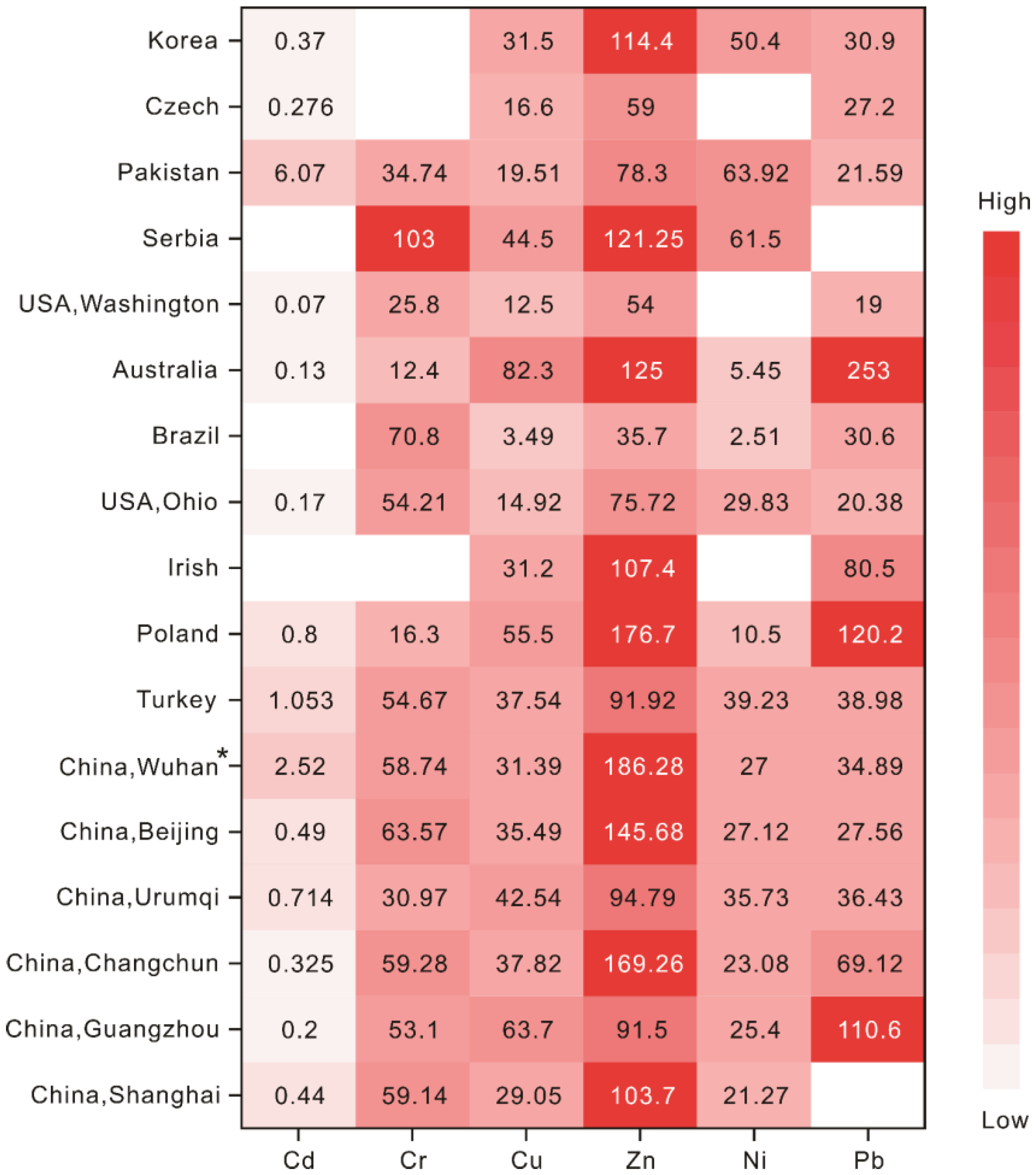
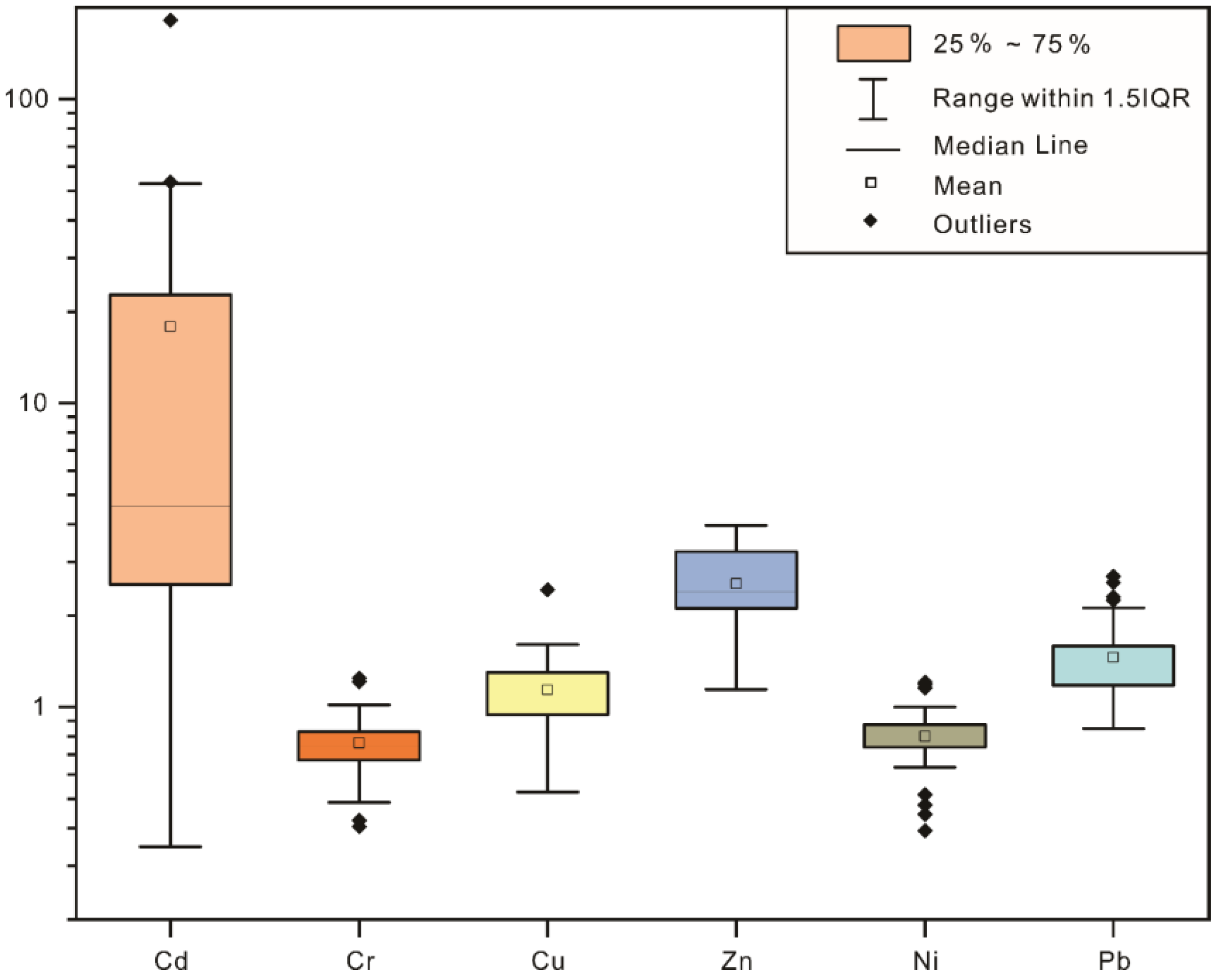

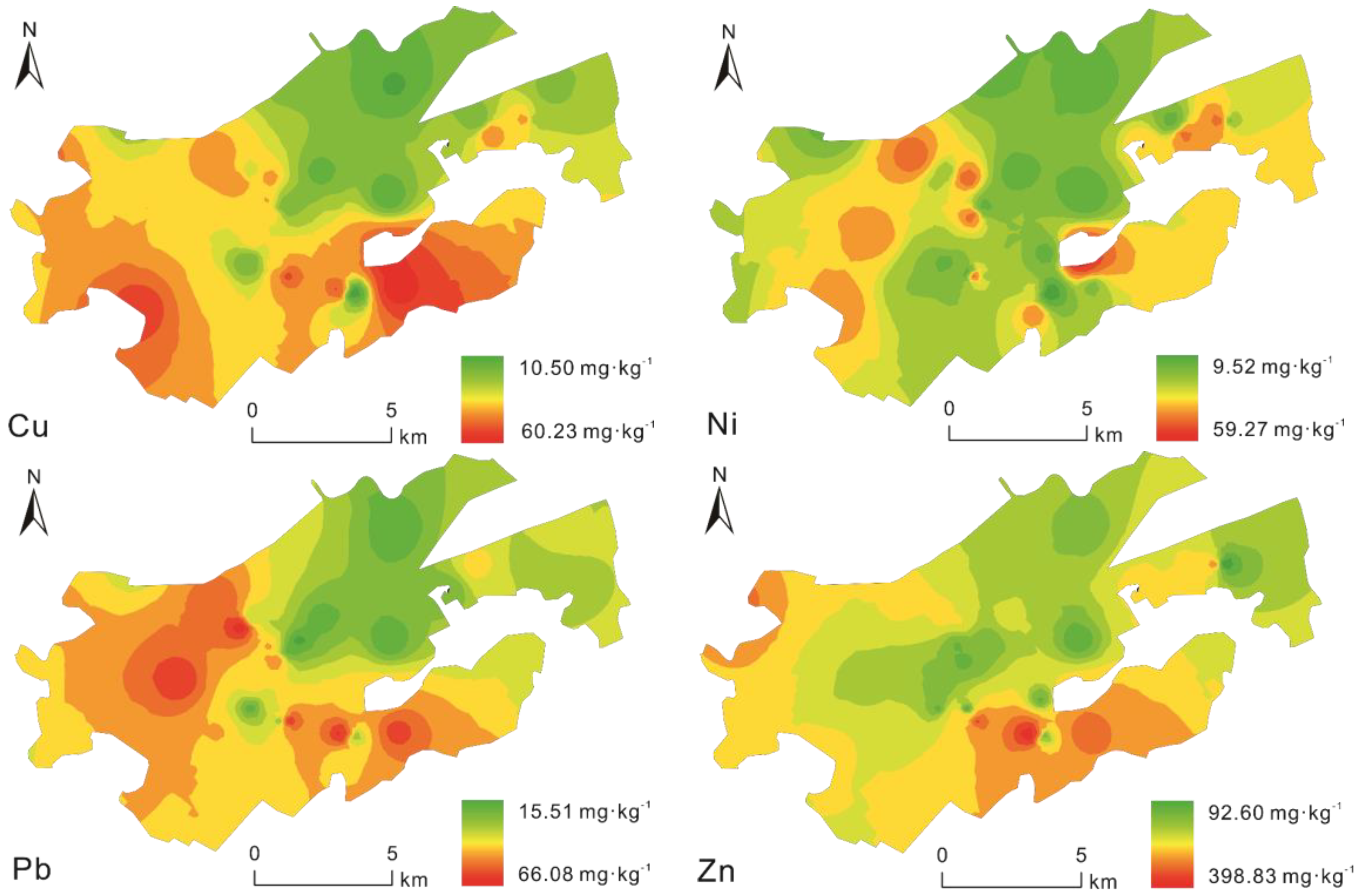
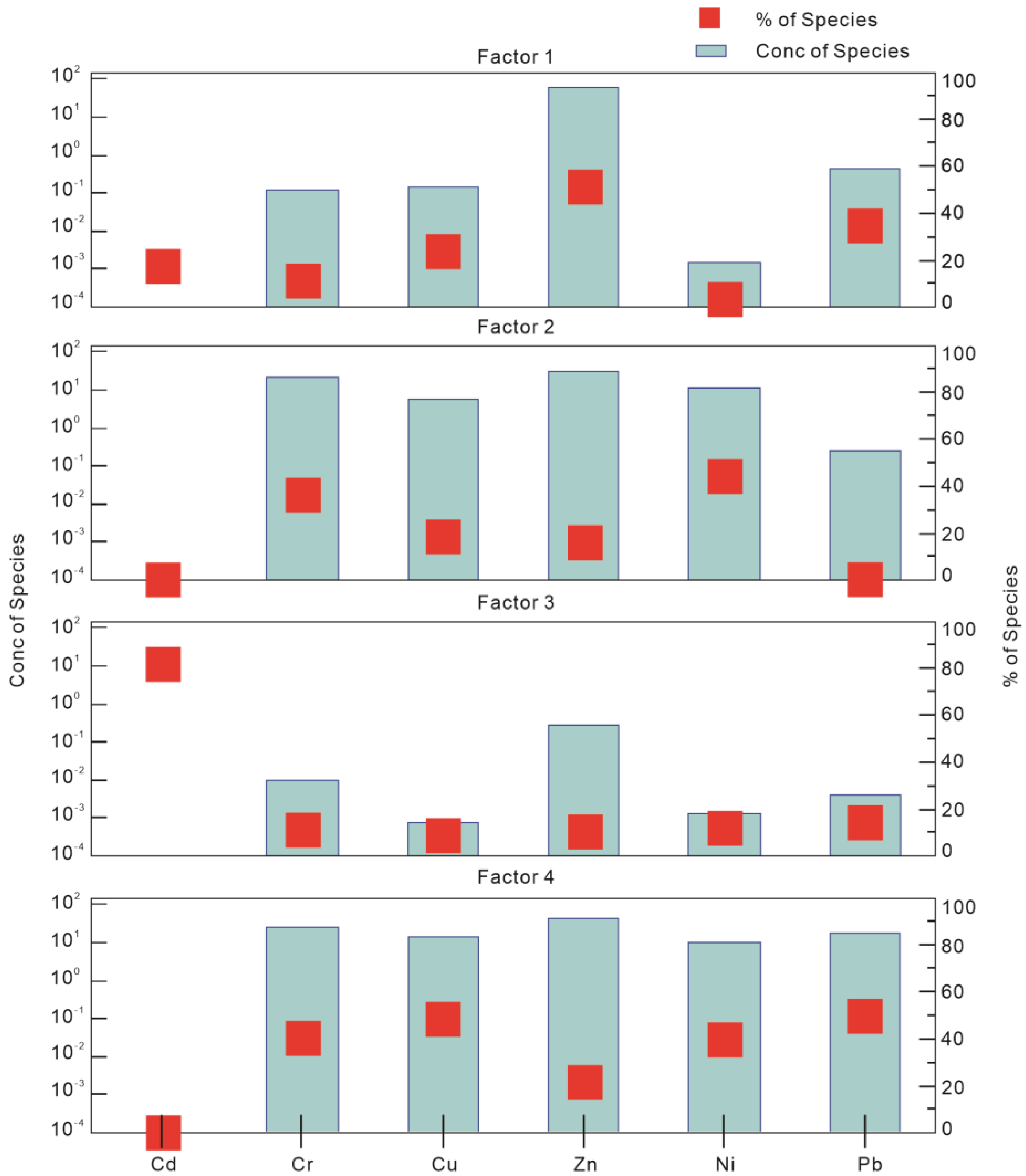
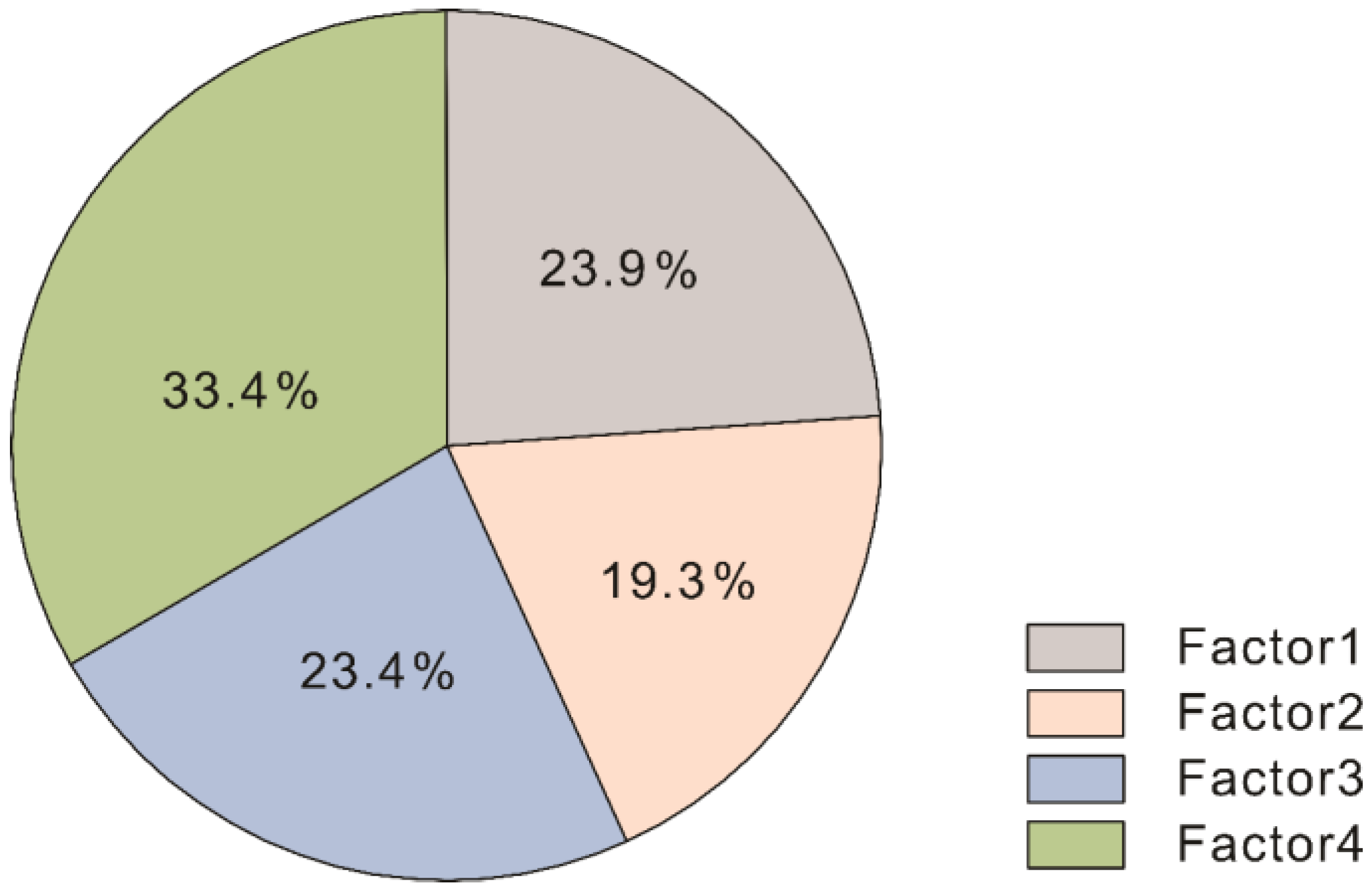
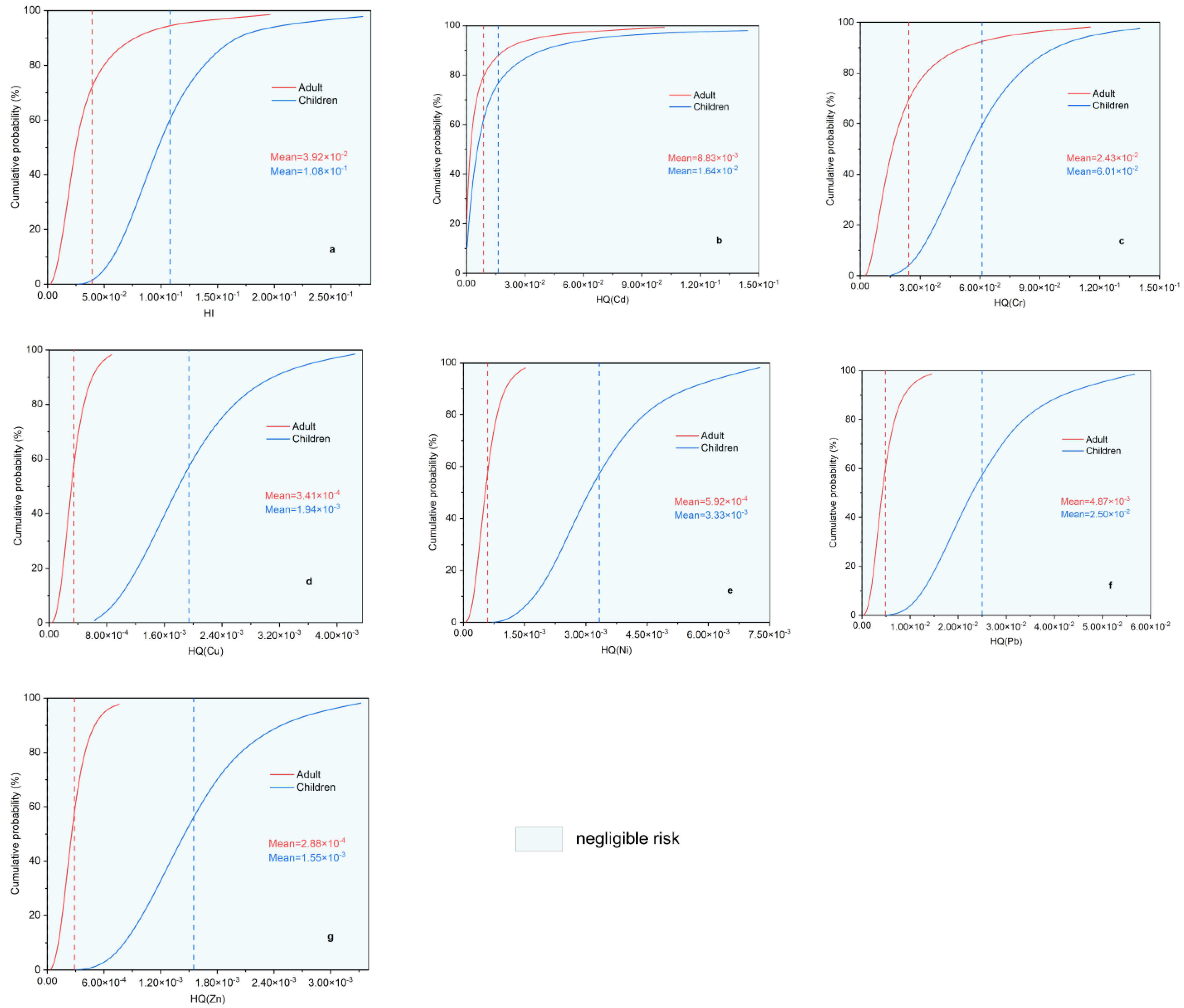
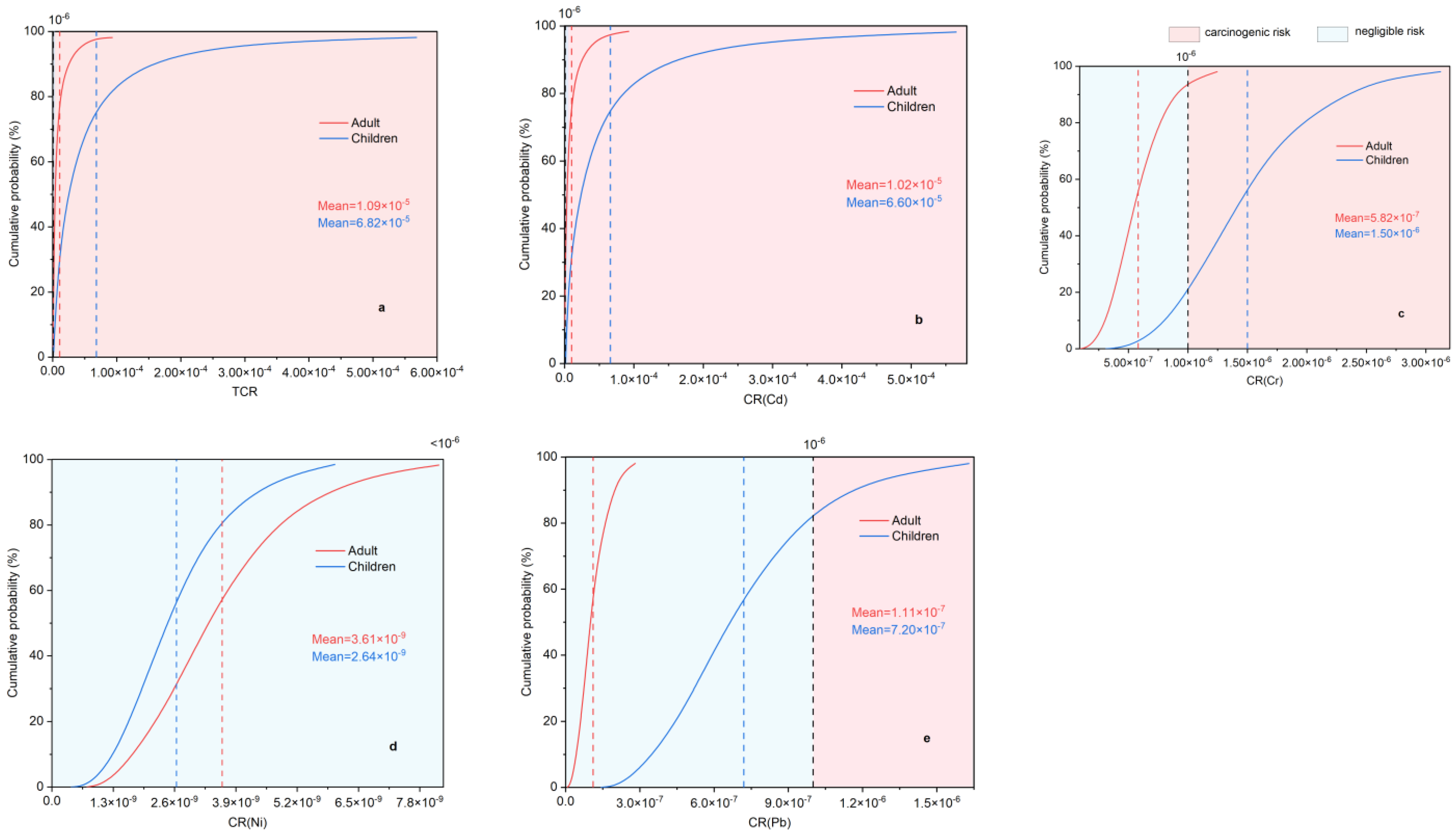
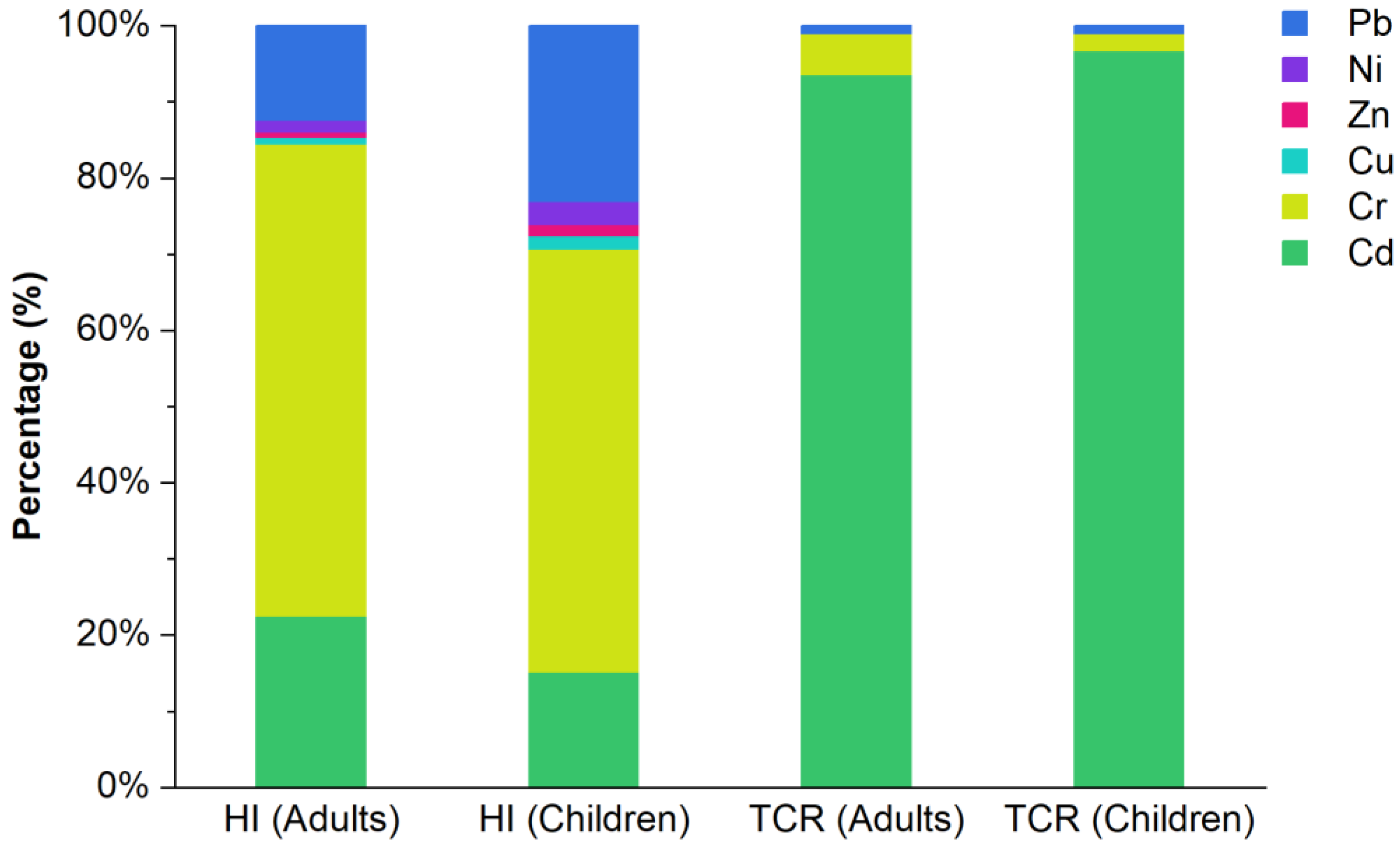
| Element | mg·kg−1 | CV% | ER% | |||||
|---|---|---|---|---|---|---|---|---|
| MIX | MAX | Mean | SD | ABV | Guide Value | |||
| Cd | 0.08 | 17.32 | 2.52 | 4.31 | 0.17 | 0.60 | 153 | 90 |
| Cr | 22.61 | 109.54 | 58.74 | 20.18 | 86 | 250 | 34.4 | 5 |
| Cu | 10.50 | 60.23 | 31.39 | 11.77 | 30.7 | 100 | 37.5 | 50 |
| Zn | 92.60 | 398.83 | 186.28 | 66.92 | 83.6 | 300 | 35.9 | 100 |
| Ni | 9.52 | 59.27 | 27.00 | 10.49 | 37.3 | 190 | 38.9 | 10 |
| Pb | 15.51 | 66.08 | 34.89 | 13.60 | 26.7 | 170 | 39.0 | 67.5 |
| Cd | Cr | Cu | Zn | Ni | Pb | |
|---|---|---|---|---|---|---|
| Cd | 1 | |||||
| Cr | 0.155 | 1 | ||||
| Cu | 0.058 | 0.755 ** | 1 | |||
| Zn | −0.05 | 0.484 ** | 0.618 ** | 1 | ||
| Ni | 0.243 | 0.840 ** | 0.651 ** | 0.286 | 1 | |
| Pb | 0.229 | 0.517 ** | 0.702 ** | 0.533 ** | 0.383 * | 1 |
Disclaimer/Publisher’s Note: The statements, opinions and data contained in all publications are solely those of the individual author(s) and contributor(s) and not of MDPI and/or the editor(s). MDPI and/or the editor(s) disclaim responsibility for any injury to people or property resulting from any ideas, methods, instructions or products referred to in the content. |
© 2023 by the authors. Licensee MDPI, Basel, Switzerland. This article is an open access article distributed under the terms and conditions of the Creative Commons Attribution (CC BY) license (https://creativecommons.org/licenses/by/4.0/).
Share and Cite
Li, D.; Lu, Q.; Cai, L.; Chen, L.; Wang, H. Characteristics of Soil Heavy Metal Pollution and Health Risk Assessment in Urban Parks at a Megacity of Central China. Toxics 2023, 11, 257. https://doi.org/10.3390/toxics11030257
Li D, Lu Q, Cai L, Chen L, Wang H. Characteristics of Soil Heavy Metal Pollution and Health Risk Assessment in Urban Parks at a Megacity of Central China. Toxics. 2023; 11(3):257. https://doi.org/10.3390/toxics11030257
Chicago/Turabian StyleLi, Ding, Qing Lu, Limei Cai, Laiguo Chen, and Hanzhi Wang. 2023. "Characteristics of Soil Heavy Metal Pollution and Health Risk Assessment in Urban Parks at a Megacity of Central China" Toxics 11, no. 3: 257. https://doi.org/10.3390/toxics11030257
APA StyleLi, D., Lu, Q., Cai, L., Chen, L., & Wang, H. (2023). Characteristics of Soil Heavy Metal Pollution and Health Risk Assessment in Urban Parks at a Megacity of Central China. Toxics, 11(3), 257. https://doi.org/10.3390/toxics11030257






